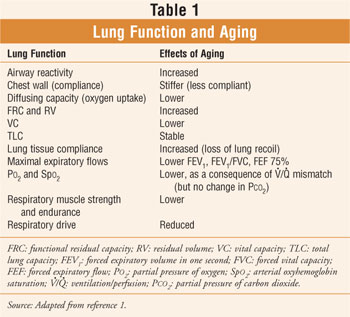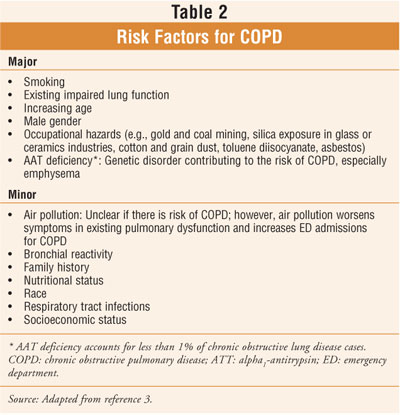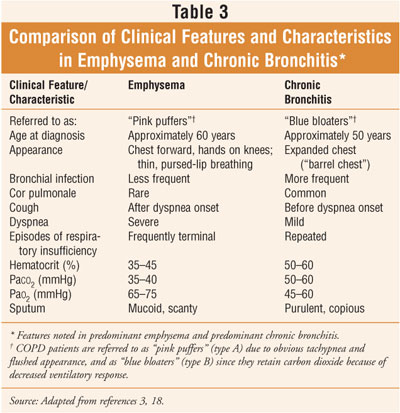US Pharm.
2006;7:28-34.
Age impacts lung function. It is an
undisputed fact that changes in lung function occur with aging in healthy,
nonsmoking individuals (Table 1).1 If an individual smokes,
the situation is compounded and havoc can strike. Chronic obstructive
pulmonary disease (COPD) is the most common chronic respiratory disease among
seniors. In addition, COPD morbidity and mortality are on the rise.1,2

Although there are numerous risk factors
associated with COPD (Table 2), the disease is largely preventable,
since its main cause is cigarette smoking. In lifetime nonsmokers in whom
exposure to environmental tobacco smoke results in at least some disease, COPD
is rare (estimated incidence 5% in three large representative U.S. surveys
from 1971 to 1984).3-5 In fact, smoking accounts for approximately
85% of COPD mortality in men and 69% of COPD mortality in women.6

A national report published in
2000 notes that 14% of all hospital admissions of elderly individuals are due
to respiratory disease.7 According to 1995 mortality statistics,
COPD and associated conditions accounted for 5% of all deaths in people 65
years and older.8 In the U.S., estimated prevalence of COPD has
risen by 41% since 1982.9 In 2003, 10.7 million adults in the U.S.
were estimated to have COPD.10 It should be noted that the terms
chronic obstructive lung disease and chronic obstructive airway disease
are synonymous with COPD.
Characterized by a progressive airflow
limitation, COPD is caused by an abnormal inflammatory reaction to the chronic
inhalation of particles, of which those from cigarette smoke are most
prevalent.3,11 For patients who continue to smoke, airway
obstruction is usually progressive, resulting in early disability and
shortened survival.9 The subsets of COPD are chronic bronchitis and
emphysema; while their pathology and clinical characteristics differ (Table
3), most individuals with COPD show characteristics of both.3

Pathophysiology and
Presentation
Chronic
bronchitis is defined in
clinical terms as chronic cough or mucus production for at least three months
in at least two successive years when other causes of chronic cough have been
excluded.3,6 Emphysema is defined in terms of anatomic pathology
and is described as an abnormal permanent enlargement of the air spaces distal
to the terminal bronchioles, accompanied by destruction of their walls
(without obvious fibrosis).1 The destruction takes place within the
acinus, the unit of the lung responsible for gas exchange. Patients with
emphysema have a decreased number of capillaries in the walls of the alveoli.
Fewer blood vessels and airway obstruction causes impaired movement of oxygen
and carbon dioxide between the alveoli and the blood.12
Patients who present with predominant
emphysema tend to be older than those who present with predominant chronic
bronchitis (Table 3). Patients with COPD may have symptoms associated
with a severely low blood oxygen level, including shortness of breath,
pulmonary hypertension, right-sided heart failure, and polycythemia (an
increase in the total red blood cell mass of the blood).12 If the
hematocrit is more than 55% to 60%, acute phlebotomy may be indicated.3
To maintain a lower hematocrit, long-term oxygen may be necessary.3
Diagnosis and Prognosis
The diagnosis of
emphysema is based on medical history, physical exam, and pulmonary function
tests. Chronic bronchitis is diagnosed solely by a history of a persistent,
sputum-producing cough.12 Due to the high prevalence of
comorbidity, the differential diagnosis of COPD and asthma in the elderly is
frequently more difficult than in younger patients.1 As compared to
middle-aged adults, elderly patients are more likely to have COPD and
cardiovascular disease, both of which are often associated with cigarette
smoking and have symptomatology mimicking asthma.1 Objective
pulmonary function (PF) tests, therefore, have great value in the elderly
population.1
In general, as airway
obstruction increases, the prognosis of a patient with COPD worsens, with an
increased risk of death.12 A steeper decline in PF is correlated
with a greater number of years spent smoking and a greater number of
cigarettes smoked.13 The prognosis is considered poor when there is
a rapid decline in PF tests.3 A reduced survival rate is seen in
individuals living in high altitudes.3
Treatment
The treatment for
COPD is palliative, not curative.2 It is probable that longevity
cannot be significantly improved with any treatment, except in patients with
hypoxemia who benefit from supplemental oxygen therapy.2
Smoking Cessation:
Smoking cessation, including cigarettes, cigars, and pipes, is the most
important step in the treatment of COPD, since smoking is the most common
cause.3,12 Smoking cessation can revert the decline in lung
function to values of nonsmokers.14 In fact, an aggressive smoking
intervention program has been shown to significantly reduce the age-related
decline in FEV1 in middle-aged smokers with mild airway obstruction.
14 Continuation of smoking essentially ensures that symptoms will worsen.
12 Pharmacists have a huge opportunity for counseling in the smoking
cessation arena with prescription and OTC medication intervention and patient
education.
Pharmacologic Interventions:
Medication intervention usually consists of life-long chronic therapy with
dosage adjustments and additional agents when exacerbations present. According
to the American Lung Association, bronchodilators (oral or inhaled) are
central to the symptomatic management of COPD. Additional treatment includes
antibiotics, oxygen therapy, and systemic glucocorticosteroids.15
Inhaled glucocorticosteroids continue to be studied.
Chronic systemic steroid
treatment poses the risk of serious side effects and is therefore usually
reserved for acute exacerbations. Patients with COPD should receive pneumonia
and influenza vaccines. Lung transplantation or lung volume reduction surgery
may be an option for certain individuals. In addition, treatments for alpha-1
antitrypsin (AAT) deficiency emphysema, including AAT replacement therapy (a
life-long process) and gene therapy, are being evaluated. For more information
on pharmacologic treatment guidelines for COPD, the reader is referred to the
Global Initiative for Chronic Obstructive Lung Diseaseguidelines at:
www.goldcopd.com.
Pulmonary Rehabilitation
A comprehensive
pulmonary rehabilitation (PR) program may lead to significant clinical
improvement by increasing exercise tolerance and reducing shortness of breath.
2 PR programs may even reduce the number of hospitalizations, although
to a lesser extent.2 It should be noted, however, that while PR
programs are aimed at improving independence and improving quality of life,
they do not improve lung function or prolong survival.2,12
Ideally, a variety of health
care professionals are required to deliver the wide range of services offered
in a comprehensive PR program. Educating patients about their disease is a key
component. Exercise training, often with oxygen, may take place at the home or
in a clinic setting and often includes stationary bicycling, stair climbing,
and walking to improve leg strength, plus weight lifting to improve arm
strength.12 Techniques are taught to decrease shortness of breath
during exercise and sexual activity. Additionally, patient evaluation and goal
setting, nutritional evaluation and counseling, psychosocial counseling
(addressing depression, anxiety, sexual activity limitations), and the
coordination of complex medical services (e.g., home visits, medical
equipment, physician visits) are also provided.2 Medication
counseling is an important and integral part of PR, since medication
nonadherence is a serious complicating factor in COPD management.2
Education regarding the appropriate dosing and timing of regularly scheduled
and as-needed medications, the proper technique for self-administering inhaled
medications, ongoing monitoring, and information for family members and
caregivers is imperative.
End-Stage Disease
Mechanical
ventilation may be necessary for short- or long-term use; some individuals may
become dependent on a ventilator until death.12 Quality of life is
diminished with mechanical ventilation due to the patient






